Small and large businesses are often seen as competitors, with small businesses owning a fierce mentality of proving themselves as a player in the game instead of an underdog. But what happens when these different sized businesses unite forces in strategic partnerships? In this session, Managing Director & Co-Head of Workday Ventures, Leighanne Levensaler will dispel the myths of partnering with large companies and reveal the 10 things that aren’t obvious with this kind of partnership.
Want to see more content like this? Join us at SaaStr Annual 2020.
Leighanne Levensaler | Managing Director & Co-Head @ Workday Ventures
FULL TRANSCRIPT BELOW
So about two years ago, nearly two years ago in August, I was about ready to go out on holiday for two weeks and it was the first time… I’ve been at Workday 10 years and it was the first time I was going out on holiday for two straight weeks. I think everybody knows what that feels like. I was very excited to go out on this holiday, ready to clear out my head and relax. The day I was leaving, my CEO, who I have a great relationship with called me and said, “Hey, I want to talk with you. I want to plant a seed.” And planting a seed in my CEO’s speak is, “Yeah, this is going to happen.” We had been talking, up until that point, we’d been talking somewhat informally about potentially creating a proper ventures fund at Workday. We’d been doing some investment, the product and technology leaders, but we talked about creating a proper investment fund to spur innovation around Workday ecosystem to get earlier stage companies, part of the Workday story for our customers.
And we had been talking about that and I also run corporate strategy. So this was part of our thinking about where are we going to take the organization. I wasn’t necessarily thinking that I was going to run this thing. So he said to me, “I want to plant a seed with you. What if you run it?” And I thought, “Oh gosh.” I said, “Well, I’m a product person, I’m not a venture capitalist.” And he goes, “Just think about it over your holiday.” And of course I’m totally neurotic, so that’s all I thought about. And the very first thing that I did, like any neurotic person is I Googled corporate venture capital. That’s how much I knew about it.
Actually what I found was a little disarming, a little unfortunate, because there was a lot of, I think, bad experiences in the past with corporate venture capital and with earlier stage companies or with other VCs working with CVCs as they were once called. It was little disconcerting for me because here I am on my holiday Googling this, trying to sort that out saying, “What am I going to get myself involved in?” Knowing that my CEO was like, “Yeah, you’re doing this. Not planting a seed.” So then when I came back to work with all these questions, we spent a lot of time just talking with other VCs, other CVCs, now in their current form. And I found some exciting things happening in a lot of investments. A vibrant space of strategic partnering with earlier stage companies and some remarkable people doing it.
So I had a lot of the old conventional wisdom or what was maybe available on Google. We were able to bust those myths and get through some things. But what I also learned in that discovery process, and really it was a discovery process. Oh, I don’t have this… They took out the slide. I had a beautiful slide here with a bunch of different colored macaroons, French macaroons. What found in that process, and my colleagues and I, was that there are so many different flavors of partnering with a large company or strategic corporate ventures. Before we get into it, we have a top 10 list of things that are not obvious about partnering with us, the big companies that is, but before that, just a little bit of a level set in that they all don’t come in the same flavor.
It’s important to understand, as you consider partnering with a large company, what their mandate is, how they’re organized. I think at the highest level there’s a big difference between the CVCs that are focused more strategically about enhancing their product and their corporate strategy, versus financially. That’s a big thing to sort out. And then there are hybrids. So just recognizing when you’re talking with a big company, what their mandate is, how they’re motivated. The other aspect that you need to consider in terms of the different flavor is, how closely associated are they with the mothership or the big company? Are they a business unit, are they properly right in the inner workings operations of the company or were they set up as a bit of an arms length, separate entity where they have a lot of freedom. That’s important to you all because if they’re… It’ll matter what areas they focus on. It’ll matter if they may competitive investments to some of the activities that they might be pursuing. It will matter on how close you are to getting access to a lot of the internal resources of that big company that you might be excited about getting access to.
The other flavor that you’ll come across are corporate venture companies that are focused on doing a lot of investments across a lot of focus areas. To the tune of several hundred in their portfolio, to on the other end of the spectrum to a company focused on just a handful of investments and going really deep in those. But also with a very sincere focus, a strike zone. So knowing what that is and knowing who you’re working with. I share all this as a prelude, because as we think about what’s not obvious about partnering with big companies, there is no one consistent standard. Just because a company is big, they really could offer their value as a strategic partner to you in a very different way, so important to understand that.
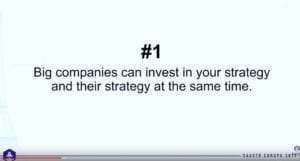 The first thing that’s not obvious about partnering with a big company is that a company can invest in their strategy and your strategy at the same time. What you really want to think about is, is the relationship mutually beneficial? Not just beneficial for the early stage company. Not just beneficial for the big company. And that for you means truly understanding why are they investing you, how are you going to help them? So as much you spend time in the diligence process with the big company or the VC trying to figure out how they’re going to help you and how you’re going to pitch to you. It’s just as important, and I know it’s competitive and a lot of people want to be in your deals, but it’s just important for you to say, “How am I going to help advance the strategy of the big company?” And I say that because that’s where you’re going to get the greatest level of partnership. That’s where you’re going to get more access to the resources, and that’s where there’s going to be a lot more benefit far beyond the actual check writing, far beyond the financial benefits. So that’s the first one.
The first thing that’s not obvious about partnering with a big company is that a company can invest in their strategy and your strategy at the same time. What you really want to think about is, is the relationship mutually beneficial? Not just beneficial for the early stage company. Not just beneficial for the big company. And that for you means truly understanding why are they investing you, how are you going to help them? So as much you spend time in the diligence process with the big company or the VC trying to figure out how they’re going to help you and how you’re going to pitch to you. It’s just as important, and I know it’s competitive and a lot of people want to be in your deals, but it’s just important for you to say, “How am I going to help advance the strategy of the big company?” And I say that because that’s where you’re going to get the greatest level of partnership. That’s where you’re going to get more access to the resources, and that’s where there’s going to be a lot more benefit far beyond the actual check writing, far beyond the financial benefits. So that’s the first one.
The second one is it can be really challenging to work with big companies. They’re big, right? They have a lot of different people on point for different aspects of the relationship.
If you’re a company and you’re five, 30, 50 people even, big companies can crush you. It’s really important that learn how to dance with the elephant, as I call it. I think, how do you do that? It’s easier said than done, but it all comes back to, at the very beginning of the relationship, the very beginning of the conversation, focusing on being clear about what your expectations are of the relationship and then ensuring that the company is going to honor those expectations. Every partnership, every relationship is about expectation management. When you’re in the getting to know each other and in the diligence process, everybody’s like, “Hey, how accommodating can we be? How easy is it going to be to work with each other?” That happens on both sides. I think sometimes it happens almost to a detriment, where you’re not really being honest and forthright about what your expectations are in the relationship.
And then lo and behold, three months, six months later, nine months later, those expectations arrive, and it’s a challenge. You might have a misalignment with all good intentions and sincerity. So being very intentional about what you expect of the relationship will help you dance with the elephant or the big company, make it a lot more smooth going. I represent Workday and we have 11,000 people at Workday and I promise you, all 11,000 people at our company want to work with our venture partners in our portfolio because many of us remember what it was like to be young and exciting and… It’s a fun stage of the company and a lot of us who are long tenured want to get back to that place, and they feel like they can do it with the venture partners.
But how does that energy and the expectations that you have match up? When we talk with our partners in our portfolio, we said, “What do you need help with?” And not just open ended. What business units, what functions can we connect to within your organization given the challenges you have? They might be sales operations challenges. Or just help me figure that out as we scale. Workday has scaled, what can we learn from that? Customer success, even social media, how do you handle that? We hear everything about privacy, data handling, because of the nature of the solution that we have in the enterprise. So important to be clear about what you’re trying to accomplish. Where are you on your business. Not just, “I need customers,” because yes you do and yes, most of the reason people want to partner with a big company is to get access to their distribution channel, to get access to their customers. But you also need help in growing your business and thinking about how you’re going to scale it. And a big company can be very supportive of that and have deep expertise in certain areas, and so just sharing what you need is critical to the relationship and to dancing.
We have one company in our portfolio that this is the third time the founding team has been together. They have two other companies. They’re in a groove, but they also know exactly what to ask of their investors. And so we get notes from them and my colleague who heads up our investments, Brittany’s in the room somewhere, we get notes from this team that are very specific. “I need this from you. This from this person in your organization.” They follow up, they send them weekly, with weekly updates because they know that if they’re going to invite a strategic into their round to invest in the company and go on the journey with them, that they’re going to reap all the benefits of doing it. I’d submit that to you all to say, “Do not be shy, and be very specific and intentional with what you need. And it’s a lot easier to deal with the size and scale of these big companies investing with you.”
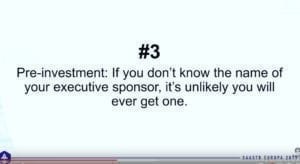 Challenge number three I think is incredibly important. If you don’t know the name of your executive sponsor… Let’s say you take money from a strategic, a CVC, and everything’s great at the beginning and brand recognition, you get to use the logo. It’s all really fun. Show up at their conference. But when it really matters is you’re trying to grow your business, you’re trying to drive opportunities, build deep customer connections. If you don’t know the name of the executive sponsor at that big company for you, that may or may not be the actual person that did the investment, you don’t have one, and that’s a problem and the relationship will suffer because of it. And a lot of what we read and learned when we were just getting started this fund, is how CVCs had a lot of promise but didn’t have a lot of execution, a lot of delivery. Have any of y’all heard that before? There’s a lot of promises made. Because it wasn’t programmatic and I think like true of anything in life, people get busy, other priorities. Again, it’s all about intention management, but just being clear on, “Okay, well who is the person that is actually going to help me connect deeper in the organization and connect with customers and do business with you? I need to know who that person is.” And it usually comes in the form of an executive sponsor.
Challenge number three I think is incredibly important. If you don’t know the name of your executive sponsor… Let’s say you take money from a strategic, a CVC, and everything’s great at the beginning and brand recognition, you get to use the logo. It’s all really fun. Show up at their conference. But when it really matters is you’re trying to grow your business, you’re trying to drive opportunities, build deep customer connections. If you don’t know the name of the executive sponsor at that big company for you, that may or may not be the actual person that did the investment, you don’t have one, and that’s a problem and the relationship will suffer because of it. And a lot of what we read and learned when we were just getting started this fund, is how CVCs had a lot of promise but didn’t have a lot of execution, a lot of delivery. Have any of y’all heard that before? There’s a lot of promises made. Because it wasn’t programmatic and I think like true of anything in life, people get busy, other priorities. Again, it’s all about intention management, but just being clear on, “Okay, well who is the person that is actually going to help me connect deeper in the organization and connect with customers and do business with you? I need to know who that person is.” And it usually comes in the form of an executive sponsor.
I know at some of the other CVCs that we admire, respect, and we do some business with, they name a GM for their investments. Workday wasn’t in that model, so we have a slightly different approach to portfolio development. But just knowing who those people are is incredibly important. Big companies, CVCs, they can get creative with financing, so generally don’t lead rounds. There are exceptions to this, of course. 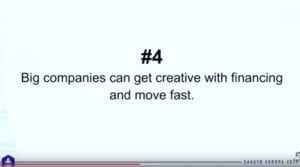 Remember we talked about all the different flavors of CVCs. But generally a big company or a corporate venture fund won’t lead a round. They will participate and join a round. As such, they’ll follow the terms. They’ll do their own diligence of course, but they’re not the actual one bringing the round together. But let’s say you want to partner with a big company. They do have an investing arm, like Workday, and you don’t have a round open.
Remember we talked about all the different flavors of CVCs. But generally a big company or a corporate venture fund won’t lead a round. They will participate and join a round. As such, they’ll follow the terms. They’ll do their own diligence of course, but they’re not the actual one bringing the round together. But let’s say you want to partner with a big company. They do have an investing arm, like Workday, and you don’t have a round open.
Don’t worry, because the investor, the CVC, can be creative with notes, convertible notes. We’ve done all sorts of things. Warrants. Lots of different ways to construct… Start to participate in the journey, start to invest in the company and then when the next round presents itself, we’re there. Sometimes that’s a good thing for your lead for the next to know that you already have, a large company, a large distribution channel, a significant strategic partnership. You already have that locked down, so it’s not looked always as a negative. There are some times where the person taking the next round wants as much of the pie as possible and is not super happy that someone has a little slice of it. That happens as well.
However, I think it’s more… In our experience, and then what we heard from others, it’s more advantageous for the earlier stage company to have a strategic ready, even in the form of a note because it just shows us a sign that they’re going to start to get some momentum or traction from that relationship. It gives a little bit more confidence in fact. And also that big companies can move fast. Again, one of the things we learned and we heard when we were doing the initial research when we didn’t know anything about corporate venture capitalists, how slow big companies are. Slow because they’re big. Slow because hard to make decisions, hard to know their governance model, who can actually write a check and get it done and how to get it through process. We’ve taken that point and I know several other firms have taken that point to heart and said, “Okay, we’re going to be fast. We’re going to be fast with a graceful no if it’s not a fit.” In our case, we’re really clear on our strike zone. There are many deals that are probably attractive deals to be in financially but not necessarily attractive deals where we’re going to drive strategic value for that partner. So we have to do a graceful no, and we have to try to do that quickly.
And then if it’s the case of diligence, let’s say the round is already coming together, by the time that happens, everybody’s ready to close. So getting a strategic in, they’re like, “Oh, I don’t want to waylay this. I don’t want to take the time.” We in particular, and I know many of our colleagues in the industry, we can move fast if need be. But again, it’s about expectation management. So ask how fast can you move? Can you get this done in five days? Can you get this done in 10 days? And just set the expectations there so you’re not waiting, you’re not holding up, your lead VC aren’t holding up either. Remember, big companies that have strategic investing arms also, in some ways the financial VCs, the leads, they’re our customers too. We have to work well, we have to show that we can move fast, we can be nimble and we’re going to be a good partner. So it is incumbent upon everybody to move quickly.
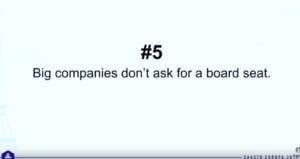 So number five, and this isn’t always the case, but I think it continues to be more the rule versus the exception, that big companies or CVCs, they’re not looking for a board seat. Understanding the complexity that that adds for the early stage company, and that it’s not attractive for a strategic or a big company to take a board seat. There are exceptions to this. Every company has their own nuance and special circumstances. But I think by and large, the idea is not to take the board seat to make you unnaturally tethered to a large company where there’s a perception maybe in the next round that you might be tethered to them in a way that’s unhealthy. An expectation. I think dispelling that myth that big companies always want a board seat and dictate your future, that is not the case. In most situations we’re there just to drive your business and help you grow and be a good partner in that journey. So that’s important.
So number five, and this isn’t always the case, but I think it continues to be more the rule versus the exception, that big companies or CVCs, they’re not looking for a board seat. Understanding the complexity that that adds for the early stage company, and that it’s not attractive for a strategic or a big company to take a board seat. There are exceptions to this. Every company has their own nuance and special circumstances. But I think by and large, the idea is not to take the board seat to make you unnaturally tethered to a large company where there’s a perception maybe in the next round that you might be tethered to them in a way that’s unhealthy. An expectation. I think dispelling that myth that big companies always want a board seat and dictate your future, that is not the case. In most situations we’re there just to drive your business and help you grow and be a good partner in that journey. So that’s important.
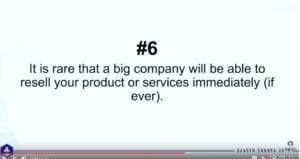 Number six, it’s rare… Again, there’s always exceptions for rules. That a big company will be able to resell your product. We hear this a lot. Can we put our product on your paper and your sales team of 4,000, 5,000 people sell a product? That would be awesome, right? To get that distribution all over the world in different market segments. Unfortunately it’s operationally that’s incredibly challenged, particularly in the age of SaaS and data privacy and the kind of agreements, terms that we in particular in enterprise software sign up with our customers. It’s very hard for an earlier stage company to adhere to the same terms. It would truly bury you as a company. So that’s one reason why on the paper.
Number six, it’s rare… Again, there’s always exceptions for rules. That a big company will be able to resell your product. We hear this a lot. Can we put our product on your paper and your sales team of 4,000, 5,000 people sell a product? That would be awesome, right? To get that distribution all over the world in different market segments. Unfortunately it’s operationally that’s incredibly challenged, particularly in the age of SaaS and data privacy and the kind of agreements, terms that we in particular in enterprise software sign up with our customers. It’s very hard for an earlier stage company to adhere to the same terms. It would truly bury you as a company. So that’s one reason why on the paper.
The other reason is with the frequency of updates and capability being delivered in a SaaS world, it’s really hard for our own sales teams to keep up with all the new capability coming out and be enabled or empowered even with what’s in their bag, so to speak, from the company. So we find that our sales teams and sales operations team are not eager to resell our partner products and not even our venture partner products. That is not unique to Workday as I understand it from our colleagues. I think this is probably just something important because we hear this as a consistent expectation. So again, important to get that out probably right away in your conversations if you’re talking to a big company.
Number seven, and this is slightly nuanced, is that if you’re partnering with a big company, their brand that they’ve established and the customer experience that they want to support for their community is paramount. That is the utmost importance to them. In our case, and I know in the case of others, we’re investing in companies to advance the state of the art of that customer experience, to help round out our solution set, to fill strategic holes, to offer more innovative solutions around us. It’s really truly the most important thing to us is our customer experience. That is our true North. Everything we do in terms of partnerships, investing, across the board is in service to that customer experience. If you can’t figure out how you’re supporting that, it’s probably not a great relationship. If you’re not paying attention to how you actually advance the brand and the customer experience of the partner, and it’s all about you, the relationship, you’re not going to win any hearts and minds of sales team, which is exactly what you want to do.
That is the utmost importance to them. In our case, and I know in the case of others, we’re investing in companies to advance the state of the art of that customer experience, to help round out our solution set, to fill strategic holes, to offer more innovative solutions around us. It’s really truly the most important thing to us is our customer experience. That is our true North. Everything we do in terms of partnerships, investing, across the board is in service to that customer experience. If you can’t figure out how you’re supporting that, it’s probably not a great relationship. If you’re not paying attention to how you actually advance the brand and the customer experience of the partner, and it’s all about you, the relationship, you’re not going to win any hearts and minds of sales team, which is exactly what you want to do.
You want to get access to our distribution channels, so they’re promoting you. Maybe not reselling, but they’re promoting you. But if you’re hurting the brand in any way, if you are not creating a nice cohesive experience for our customers, our sales team are going to be reticent to put you in front of their customers. They don’t want to risk anything in a deal. They manage a deal. They’re maniacal in how they manage their deals, and so they want no friction. I just share that as an important… You get the benefits of channel, but you also have to really think about how you’re helping. We’re so excited about… We’ve made 12 investments in the last year. Our portfolio is 19 strong because we had been making some investments prior to this new mandate and this fund that… We have a $250 million fund we launched last February. But we have 19 portfolio companies. We love them all. Our team, we take care of them. Our partnership community takes care of them. But we have thousands of salespeople and it’s incumbent upon us to almost sell in our portfolio companies to our salespeople to then sell. So having a strong value proposition about how you’re going to help them close business? Really important.
 Again, nothing I’m really saying here is unique to our own company experience. When you work with a big company, they have financial reporting requirements. That’s compulsory. I think in our case we try not to do side letters. We know that creates friction for you in deals. It’s not fun, but there is a modicum, a basic amount of information that we do have to report on. Knowing that upfront, having the ability to be on a regular cadence to connect on your financial performance and metrics, extremely important to large companies. I don’t know a large company’s accounting team that will let them get past this.
Again, nothing I’m really saying here is unique to our own company experience. When you work with a big company, they have financial reporting requirements. That’s compulsory. I think in our case we try not to do side letters. We know that creates friction for you in deals. It’s not fun, but there is a modicum, a basic amount of information that we do have to report on. Knowing that upfront, having the ability to be on a regular cadence to connect on your financial performance and metrics, extremely important to large companies. I don’t know a large company’s accounting team that will let them get past this.
And then nine, we want to use the products and services of the companies we invest in. However, usually the investing team is not the functional leader in the company that takes the buying decision and has the purse or the wallet to do that, and they can’t force… Like in our case, we can’t force our recruiting team or our privacy team or our InfoSec team to buy something that we’ve invested in. We will try. We will sponsor it. We will broker meetings, but it’s not a guarantee that the company that’s investing you will be your customer. I think that’s important. Now I would say in most cases, in our situation, eventually, not day one but a couple months in or even pre-day one, that’s maybe why we invested in them, we are their customer but not in all cases. And it’s not always within the investing team’s control for that.
So lots of questions. Actually, we got some this morning when we were doing our meet and greet brain date thing and just lots of questions throughout the day on like, “Well, if I let Workday give me money…” If I let Workday give me money. “Can you be our customer?” And I’m like, “Well, there’s so much wrong with those statements.” An all in one, but really important. I think that the ambition, the drive is… And look, big companies, and in our case, when we’re looking at a product and it’s in a functional area, a focus area that we have experts in internally or we have buyers internally, we bring them into the diligence process. We get a sense, if they won’t use it, if we won’t use it, should we invest in it and why? Maybe it’s not an industry fit, so okay, there’s that. But if our own team wouldn’t consider using it, we think a lot about that, because there’s also this brand thing where if we invest in a company, our customers say, “Well, does Workday use it?” So it’s a sign. It’s incumbent upon us to help you get the business, but not guaranteed.
Another important one, and this is the last one, so it’s a good exit one. A big company may not be your exit. In fact, it’s not super attractive when people approach you as a big company to say, “We want you to buy us later in our journey.” Frankly, we’re looking at making investments in companies that are going to go big and they want to go out and they want to go out public and they want to… They’re going after big markets and big problems and they believe that they’re going to be an enduring long term organization. They’re setting themselves up for success that way. Not that they’re prepping themselves for an exit. Now that might be inevitable and it is inevitable in a lot of cases that they’ll have an exit prior to an IPO. But that is not necessarily an attractive quality.
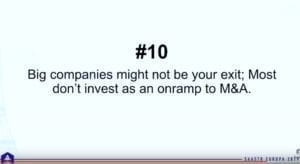 Moreover, many strategic investing arms, including ourselves, don’t see investing as an on ramp to M&A. Will we potentially acquire a company or two or three in our portfolio? Absolutely. I don’t know which ones, but that wasn’t the design point going in. That wasn’t the intention of making the investment. When we talked about the macaroons and the different flavors of corporate venture capital, there are firms that do use their strategic investing arm as an on ramp for M&A, and so just know that. And that’s good, that might be an awesome thing for you and you may be desirous of that. And then there are others… They’re in fact saying, “I don’t think I’m going to buy this. I don’t think I’m going to build this internally and therefore I’m going to invest invest in this and have a deep partnership.”
Moreover, many strategic investing arms, including ourselves, don’t see investing as an on ramp to M&A. Will we potentially acquire a company or two or three in our portfolio? Absolutely. I don’t know which ones, but that wasn’t the design point going in. That wasn’t the intention of making the investment. When we talked about the macaroons and the different flavors of corporate venture capital, there are firms that do use their strategic investing arm as an on ramp for M&A, and so just know that. And that’s good, that might be an awesome thing for you and you may be desirous of that. And then there are others… They’re in fact saying, “I don’t think I’m going to buy this. I don’t think I’m going to build this internally and therefore I’m going to invest invest in this and have a deep partnership.”
Last I didn’t properly credential ourselves at the beginning because I wanted to get in the content, but just briefly, I think big companies come in all shapes and sizes. Generally several thousand people, but Workday in particular, we have now 27 plus hundred companies. We just were awarded number one best place to work in the UK, number three in Europe, in addition to these other accolades on here. Culture is everything to us, and this is why I’m sharing this. I think our very first filter on companies is culture fit. Don’t have to be the same as us and it’s impossible to be the same as any other culture. But a strong sense of culture and talent development is where we look and I know my colleagues at other strategic investing arms do.
And then lastly some of our benefits of Workday Ventures are our partnerships. One of the things that we said at the very beginning is that we’re not just going to be financial capital. We are going to be strategic and strategic for our companies means I will be a Workday partner, you will build it, and we will build an integration and we will go to market together. We’ve set up our entire fund to support these programmatically with our resources. I’m at time, because I got a few minutes late starting, but I’m happy to take any questions. I appreciate y’all coming at the end of the day and a lot of attention to this and it’s exciting. We’re having a ball working with early stage companies, and I know our portfolio companies really enjoy being part of our community. It’s a good thing to partner with big companies. It’s a very good thing. So thank you. Have a nice rest of the day.

